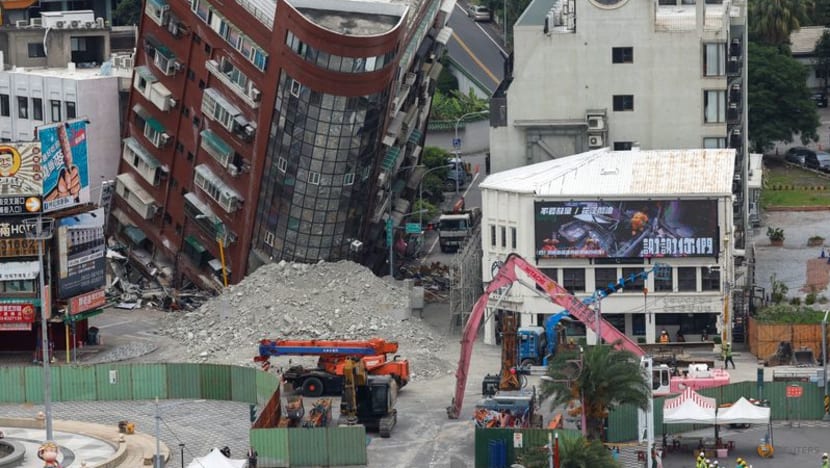CNA Explains: What should you do if you’re caught in an earthquake?
A 7.2 magnitude earthquake struck Taiwan earlier this week, claiming the lives of a dozen people. An expert gives CNA some basic survival tips.

A damaged building following the earthquake, in Hualien, Taiwan on Apr 5, 2024. (Photo: Reuters/Carlos Garcia Rawlins)

This audio is generated by an AI tool.
SINGAPORE: A 7.2 magnitude earthquake struck Taiwan’s eastern county of Hualien on Wednesday (Apr 3), killing 12 people and injuring more than 1,000 in the strongest quake to hit the island in 25 years.
Taiwanese authorities are searching for 18 people who are still missing, while hundreds were stranded in a national park as fallen boulders cut off road access.
Taiwan, which lies near the junction of two tectonic plates, is no stranger to earthquakes. A devastating earthquake that claimed the lives of more than 2,000 people in 1999 led to the island significantly upgrading its infrastructure.
Related:
What do you do when a quake strikes?
If you happen to be caught in an earthquake, you should “drop, cover and hold on” when you start to feel the shaking, Associate Professor Wei Shengji from Nanyang Technological University’s Asian School of the Environment told CNA938.
The earthquake researcher elaborated on the three steps:
- Drop down on your hands and knees
- Cover your head and neck, which are the most vulnerable parts of your body
- Hold on your shelter or something stable, such as the legs of a strong table
If possible, you can look online on your mobile phone or computer to figure out the location and magnitude of the quake as well to determine how bad the damage is, said Assoc Prof Wei.
For example, if you are 30 to 40km away from a magnitude 6.0 quake, the damage there is likely to be relatively minor. It is probably safer to get out of a building in this case when there is less severe shaking.
However, a quake of magnitude 7.0 striking the same distance away could cause much worse damage. It is likely dangerous to leave the building in that instance, Assoc Prof Wei cautioned.
What if you’re indoors or in a high-rise building?
If you have access to open space and can quickly get out, that would be a wise thing to do, said Assoc Prof Wei.
However, if you’re on higher floors in a high-rise building, it is not safe to attempt leaving. You should practise the “stop, cover and hold on” routine and wait for further instructions.
Stay calm and try to get food and clean water, as well as a whistle or anything that could generate noise and prove helpful if you need to be rescued.
This also applies if you are trapped in a collapsed building. For those in this situation, Assoc Prof Wei cautioned avoiding fire at all costs.
“In many of these cases, for example, a gas pipeline could be broken so the gas could be out there in the air. So if you are lighting up a match, trying to find some light, it is a very dangerous thing to do,” he added.
If you are at the top of high-rise buildings, you will feel a longer period of shaking that is less violent in general as well and you could grow dizzy, Assoc Prof Wei said.
What if you’re outdoors?
Avoid being close to a bridge, tall buildings or trees if you’re outdoors when a quake hits. Get to open space as quickly as possible.
If you happen to be driving, slow down, get out of traffic, find an open space and stay in your vehicle until the shaking stops, said Assoc Prof Wei.
You should also avoid areas with steep slopes as they are more vulnerable to landslides, like during the Taiwan earthquake. Mine workers were left stranded on a mountain ledge when the quake triggered landslides that destroyed or blocked their exit paths.
Is it safe to use electricity or water immediately after?
Avoid using gas and fuel pipelines, given their high flammability.
Getting water from a trap is “relatively safe” and you should fill your water bottle before utilities are cut off, if they have not already been from the earthquake, said Assoc Prof Wei.
When will it be safe to return?
Even if there are no visible signs of damage or the building is still standing, you should not go back because aftershocks will take place after a big quake. Assoc Prof Wei noted that a building might survive the main shock but an aftershock could knock it down.
Whether it is safe to return also depends on several factors, like the magnitude of the quake and the level of shaking.
You should look for information on the quake online and wait for official information from your government and scientists.















